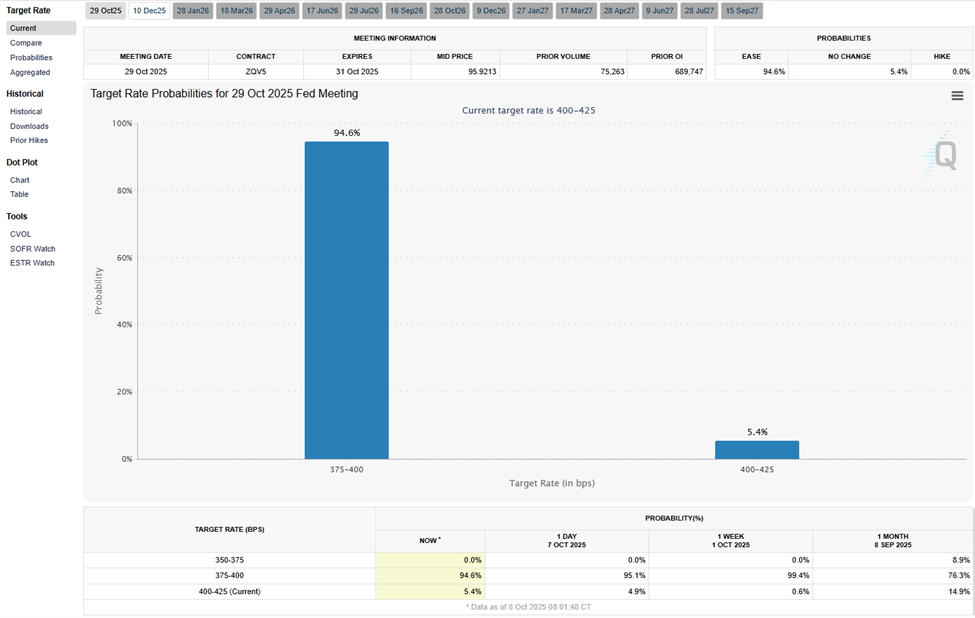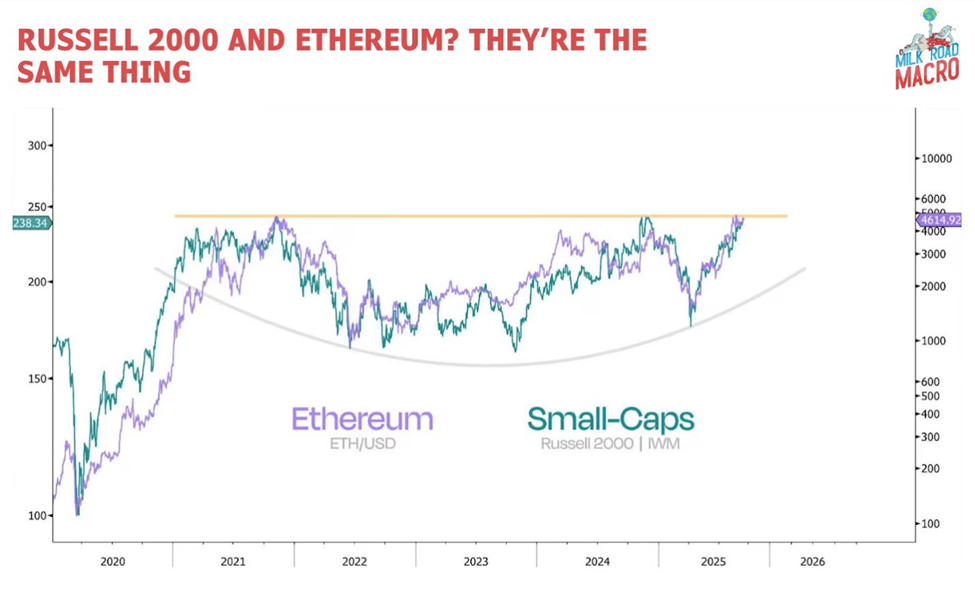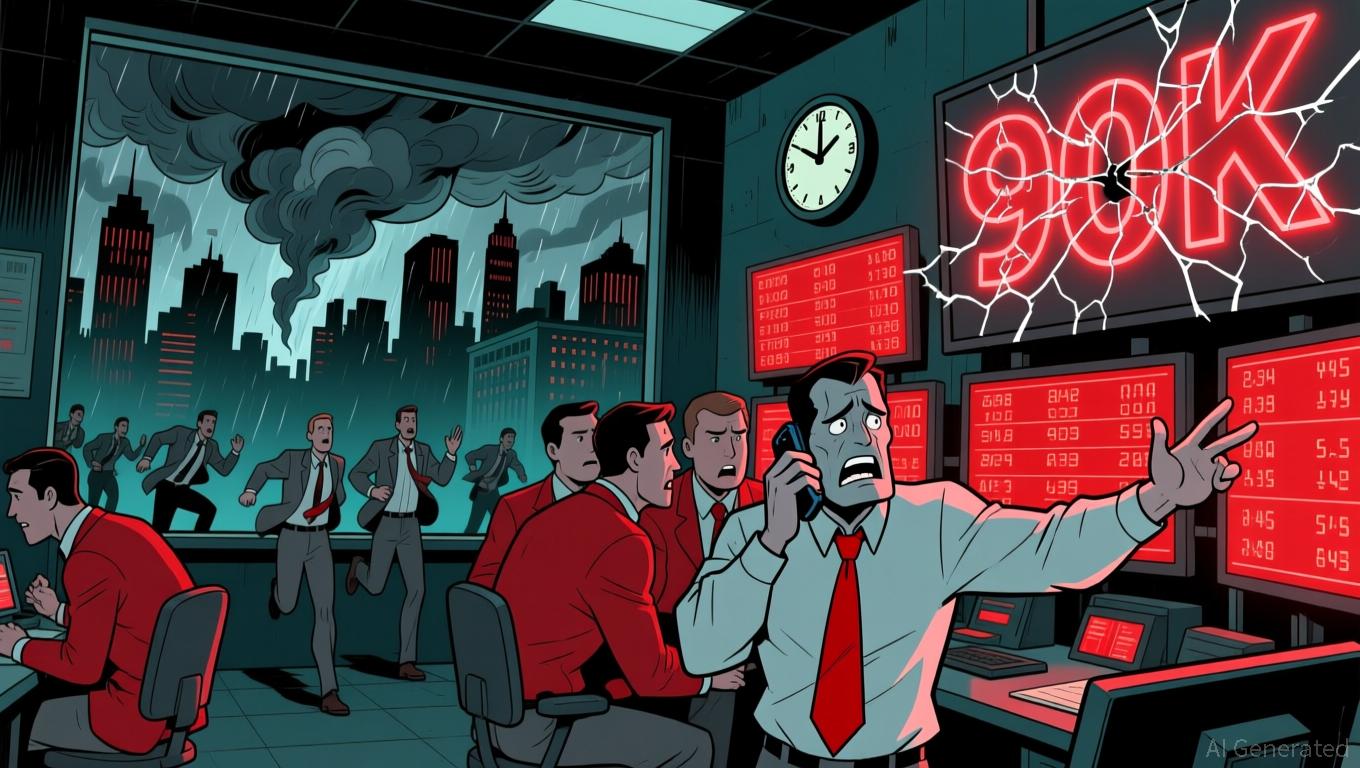Russell 2000 May Be the Hidden Compass for Ethereum’s Next Big Move | US Crypto News
A growing correlation between Ethereum and the Russell 2000 is catching traders’ attention. With rate cuts ahead, both risk assets may be gearing up for gains.
Welcome to the US Crypto News Morning Briefing—your essential rundown of the most important developments in crypto for the day ahead.
Grab a coffee because markets are moving in strange harmony again. From small-cap stocks to Ethereum (ETH), patterns once thought unrelated are beginning to sync. While some call it a coincidence, others see a deeper signal about where risk capital is heading next as rate cuts loom.
Crypto News of the Day: Why the Russell 2000’s Rally Could Be a Signal for Ethereum’s Next Move
A striking correlation is emerging between the Russell 2000 and Ethereum, two very different risk assets that now appear to be moving in lockstep.
Analysts at Milk Road highlighted the relationship, noting that both are hypersensitive to interest rate cuts and liquidity cycles.
With markets pricing in four consecutive rate cuts through year-end, Milk Road says, “expect both of them to move up in tandem.”
“This correlation is almost spooky. The Russell 2000 (small-cap equities) and ETH are basically moving in sync. Both are highly sensitive to interest rates. With 4+ consecutive cuts on the horizon… Expect both of them to move up in tandem,” they wrote.
The pattern has been building since April, when the Russell 2000, an index tracking US small-cap stocks, began outperforming the broader market. It has gained over 42% since bottoming on April 7, outpacing the S&P 500’s 36% rise.
The surge has coincided with renewed speculation, reported in a recent US Crypto News publication, that the Federal Reserve will continue cutting rates following its 25bps move on September 17. Traders assign over a 94.6% probability to another cut by late October.
 Fed Interest Cut Probabilities. Source:
Fed Interest Cut Probabilities. Source:
The parallel with Ethereum makes sense to macro traders as both assets thrive in risk-on environments fueled by cheaper capital.
On the one hand, small-cap companies benefit directly from lower borrowing costs. On the other hand, Ethereum tends to attract liquidity inflows as investors rotate into growth and innovation-oriented risk assets during easing cycles.
The Russell 2000’s tech sector hitting an all-time high is a milestone that some analysts like see as an early proxy for crypto market momentum.
“Russell 2000 vs ETH Price. This is a fascinating combination of TradFi and crypto. Just as ETH acts as an index for Altcoins (smaller cryptocurrencies), the Russell 2000 represents small-cap stocks in traditional markets. It’s a correlation most traders overlook, yet it can reveal valuable insights about market risk cycles and investor appetite,” wrote analyst Joao Wedson, CEO and founder of Alphractal.
The Small-Cap Mirage and What It Means for Ethereum
However, not everyone is convinced that the small-cap rally or Ethereum’s correlation signals sustainable growth. Investor Oguz argues that small caps are dying, pointing to a decades-long trend of mega-cap dominance in digital and mobile-driven economies.
“The internet and mobile have created winner-takes-all markets…Companies like Meta and Spotify become so large and profitable that they can leapfrog competitors across industries. This trend won’t reverse anytime soon. Long mega-caps,” he said.
That view frames the concern that if the small-cap rally proves temporary, Ethereum could face similar cyclical headwinds as a proxy for decentralized innovation.
Both ecosystems rely on broad-based risk appetite, not concentrated capital flows into giants like Apple or BlackRock.
Still, near-term momentum remains undeniable. The Russell 2000’s five biggest holdings, including IonQ, Bloom Energy, and Kratos Defense, have rallied an average of 90% since August, despite many lacking consistent profitability.
This surge, fueled by rate expectations and risk tolerance, mirrors Ethereum’s rally patterns during liquidity expansions.
Perhaps the key distinction lies in structural utility. Unlike small caps, Ethereum is growing into a settlement layer for decentralized finance, tokenized assets, and smart contracts. This positions it for longer-term relevance even as small-cap equities fluctuate.
Whether this correlation holds or diverges, both markets point to a restored risk appetite, with liquidity steering the narrative.
Chart of the Day
 Russell 2000 and Ethereum Correlation. Source:
Russell 2000 and Ethereum Correlation. Source:
Byte-Sized Alpha
Here’s a summary of more US crypto news to follow today:
- Bitcoin faces new rival as tokenized gold surges past $3 billion — The real “digital gold”?
- BNB super cycle or super bubble? Analysts split on Binance’s moonshot.
- XRP’s bullish flag points to $4, but this indicator says “not yet”
- Peter Brandt just made a new XRP price prediction — Here’s the breakdown.
- Bitcoin ETF volume hits $7.5 billion, cementing Wall Street’s crypto pivot.
- Bank of England softens stablecoin cap plan after pushback. Here’s what happened.
- US Labor Union pushes back on RFIA crypto bill over pension fears.
- Ethereum slips below $4,500 despite Grayscale staking 300,000 ETH.
- Gold’s $4,000 rally echoes the Nixon era — and Bitcoin is the modern winner.
Crypto Equities Pre-Market Overview
| Company | At the Close of October 7 | Pre-Market Overview |
| Strategy (MSTR) | $328.40 | $334.66 (+1.91%) |
| Coinbase (COIN) | $375.78 | $377.20 (+0.38%) |
| Galaxy Digital Holdings (GLXY) | $39.58 | $41.12 (+3.88%) |
| MARA Holdings (MARA) | $20.25 | $20.41 (+0.77%) |
| Riot Platforms (RIOT) | $21.47 | $21.66 (+0.88%) |
| Core Scientific (CORZ) | $17.10 | $17.24 (+0.825) |
Disclaimer: The content of this article solely reflects the author's opinion and does not represent the platform in any capacity. This article is not intended to serve as a reference for making investment decisions.
You may also like
Hyperliquid News Today: MUTM Soars by $19M While MegaETH Plummets: Real Performance Outshines Hype in the Evolving Crypto Landscape
- Mutuum Finance (MUTM) raised $19M in Phase 6 presale, with 250% price growth since 2025 launch and 90% allocation completed. - KuCoin secured AUSTRAC and MiCA licenses, expanding compliance reach across 29 EEA countries while acquiring payment firms to strengthen institutional credibility. - Bitcoin surged past $90K amid Fed rate cut speculation, contrasting MegaETH's $1B token sale collapse due to technical failures, highlighting execution risks in volatile markets. - Crypto exchanges pledged $3.19M for

Bitcoin News Update: Triple Bearish Divergence in Bitcoin Suggests ETF Rally May Be Unstable
- Bitcoin trades near $86.6K, down 31.3% from October peak amid $3.5B November ETF outflows and $2B liquidations. - Technical analysis flags "triple bearish divergence" as price hits higher highs while momentum indicators weaken. - Spot Bitcoin ETFs see $238M inflows but face $90K resistance; Ethereum ETFs gain $175M yet ETH remains below $3,000. - Key support at $85K risks accelerating sell-off to $80K, with 50–60% retracement targeting $34,409–$44,100 if bearish pattern completes.

CME Outage Highlights Cooling Systems as the Global Market’s Major Vulnerability
- CME's 2025 outage exposed cooling systems as critical vulnerability, halting 90% of global derivatives trading via CyrusOne data center failure. - Frozen prices in WTI, S&P 500 futures, and gold triggered erratic movements, with silver dropping $1 amid widened bid-ask spreads. - Despite robust financials ($1.54B revenue Q3 2025), CME faces infrastructure scrutiny as crypto futures growth plans clash with outage risks. - 24/7 crypto trading expansion scheduled for 2026 highlights need for resilient system
Gold Climbs as Fed Faces Uncertainty Over December Rate Cut Amid Limited Data
- Gold prices hit $4,120/oz as Fed rate cut expectations dropped to 33% due to delayed November jobs data, triggering market uncertainty. - JPMorgan and Goldman Sachs project gold to reach $5,055/oz by 2026, citing central bank demand and potential Fed policy neutrality. - Asian markets showed mixed performance while U.S. equity futures wavered, reflecting fragility amid geopolitical tensions and Fed leadership speculation. - Geopolitical risks, including U.S.-Ukraine peace talks and China's semiconductor

